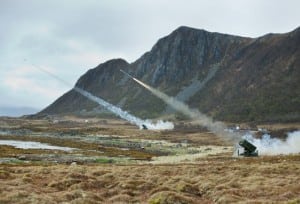The State Department has approved a potential $3 billion deal with Kuwait for the National Advanced Surface-To-Air Missile System (NASAMS) medium range air defense system.
The Defense Security Cooperation Agency (DSCA) notified Congress on Thursday of the new foreign military sale.
Raytheon Missiles and Defense
[RTX] and Norway’s Kongsberg jointly developed the NASAMS air defense system, which brings together Raytheon’s Sentinel radar and Advanced Medium Range Air-to-Air Missiles with Kongsberg’s Fire Distribution Center.

Photo: Raytheon
Under the deal, Kuwait would specifically receive a NASAMS capability consisting of seven Sentinel radars, 63 AMRAAM missiles, 63 extended range AMRAAMs and 63 AIM-9X Sidewinder Block II tactical missiles.
“The proposed sale will improve Kuwait’s capability to meet current and future threats by enhancing the ability to defend itself against regional malign actors and improve interoperability with systems operated by U.S. forces and other Gulf countries. Kuwait’s continued investment in its defensive capabilities is crucial to protecting its borders, energy infrastructure, and its residents, including over 4,000 U.S. citizens and military personnel living and working in the country,” DSCA officials wrote in a statement.
Raytheon was also awarded a $182.3 million deal in late August to supply NASAMS to Ukraine, after the system was included in a previously announced security aid package to be procured with Ukraine Security Assistance Initiative funds (Defense Daily, Aug. 29).
Investment firm Cowen noted the new Kuwait FMS case signals a strong start for FY ‘23, after the DSCA announced $75 billion in cases, although not all finalized, in FY ‘22.
“Still FY ‘22 was a solid year and there should be a meaningful pipeline of contracts to be negotiated in the months ahead. For comparison, FY ‘21 was $87 billion and FY ‘20 was $83 billion but similarly included cases that may not convert into contracts,” Cowen wrote in a report. “We believe U.S. sales could reverse the recent downtrend and possibly grow next year due to: a prolonged [Russia-Ukraine] conflict and need to sustain [Ukraine] with advanced U.S. munitions; increased NATO spending; and increased spending in Asia by countries such as Japan and Australia.”